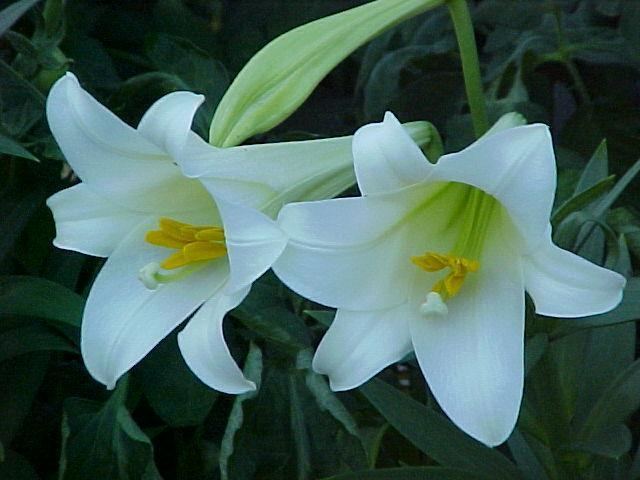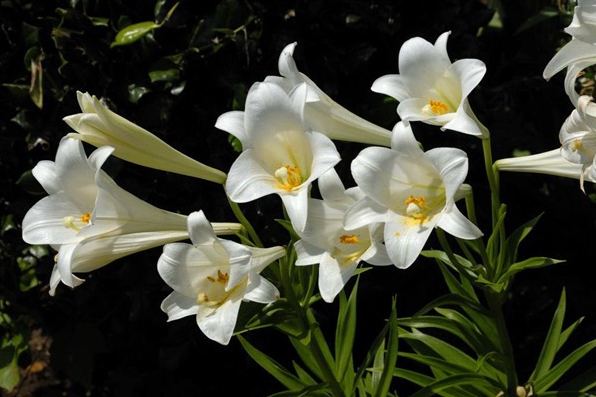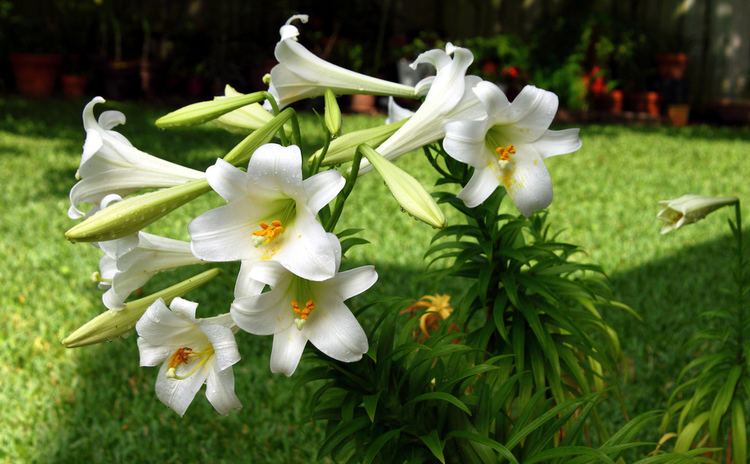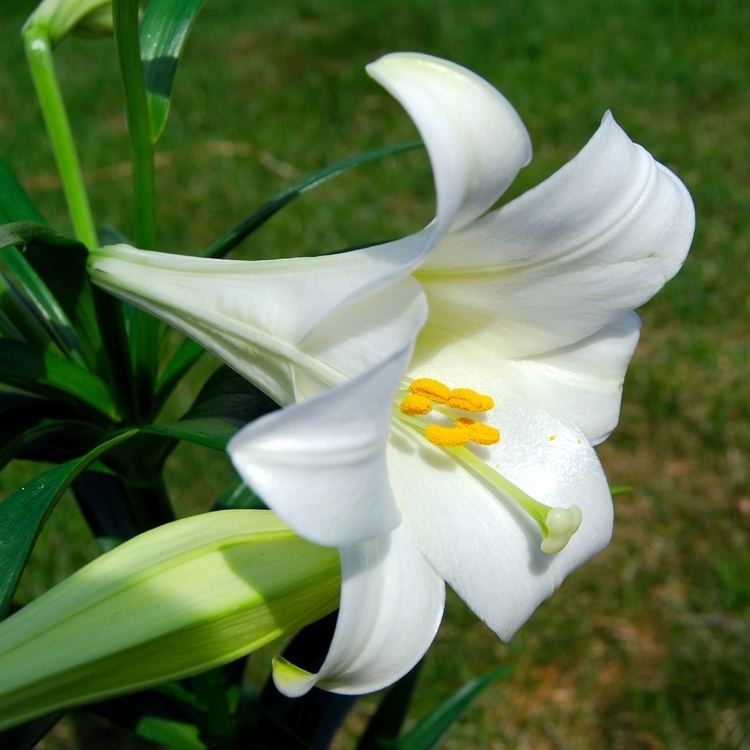Rank Species | Genus Lilium Higher classification Lily | |
 | ||
Similar Lily, Lilium candidum, Tiger lily, Lilium martagon, Liliaceae | ||
Lilium longiflorum flowering in wilderness orchard delhi
Lilium longiflorum (Japanese: テッポウユリ, Teppōyuri), often called the Easter lily, is a plant endemic to the Ryukyu Islands (Japan). Lilium formosana, a closely related species from Taiwan, has been treated as a variety of Easter lily in the past. It is a stem rooting lily, growing up to 1 m (3 ft 3 in) high. It bears a number of trumpet shaped, white, fragrant, and outward facing flowers.
Contents
- Lilium longiflorum flowering in wilderness orchard delhi
- Lilium longiflorum easter lily in the ground
- Features
- Cultivation
- Use in Eastertide
- History
- Chemistry
- Toxicity
- References

Lilium longiflorum easter lily in the ground
Features

Plants tend to grow from about 50 cm (20 in) to 1 m (3 ft 3 in) tall. They have long oval leaves and the vein enters the horizontal direction. From April to June, the plant's flowering season, it produces pure white flowers on top of the stem. The stem has a cylindrical shape, with a diameter of about 5 cm (2.0 in).
Cultivation

A variety of it, L. longiflorum var. eximium, native to the Ryukyu Islands, is taller and more vigorous. It is extensively cultivated for cut flowers. It has irregular blooming periods in nature, and this is exploited in cultivation, allowing it to be forced for flowering at particular periods, such as Easter. However, it can be induced to flower over a much wider period. This variety is sometimes called the Bermuda lily because it has been much cultivated in Bermuda.

One hundred percent of all Easter lily bulbs used in the United States and Canada are grown on coastal bottom lands in northwestern California and southwestern Oregon. Production of Easter lily bulbs has been controversial because pesticides used to grow the lilies are polluting streams that feed the estuary of the Smith River, California's healthiest and most important river for salmon and steelhead. In 2013 the California North Coast Regional Water Quality Control Board found "acute (and) chronic reproductive toxicity" in three of the four primary creeks that feed the Smith River estuary. One local group, Siskiyou Land Conservancy, has been working since 2004 to reduce pesticide use in the lower Smith River. Research by Siskiyou Land Conservancy found that Easter lily growers use 300,000 pounds annually of highly toxic pesticides. Two of these pesticides — metam sodium and 1,3-dichloropropene, both carcinogens and both deadly to aquatic species — are used in pounds-per-acre amounts that rival any other region of California. A Health Assessment conducted by Siskiyou Land Conservancy found that these pesticides are sickening local residents.
Use in Eastertide

Lilium longiflorum is known as the Easter lily because in Christianity, it is a symbol of the resurrection of Christ, which is celebrated during Eastertide. The "lily has always been highly regarded in the Church", as Jesus Himself referenced the flower, saying "Consider the lilies how they grow: they toil not, they spin not; and yet I say unto you, that Solomon in all his glory was not arrayed like one of these" (Luke 12:27). Moreover, according to pious legend, "after Jesus' death and resurrection, some of these beautiful flowers were found growing in the Garden of Gethsemane, where Jesus went to pray the night before His crucifixion. Legend has it that these flowers sprung up where drops of Jesus' sweat fell as he prayed". In many Christian churches, the chancel is adorned with Easter lilies throughout the Paschal season. A poem of the early 1900s titled Easter Lilies by S.R. Allen, delineates this custom:
Somewhere while the Easter lilies
Swing their perfumed censers white,
Softened rays of sunlight falling
In lines aslant, and warm, and bright,
Shall gild the altar, nave and chancel;
Rest with tender roseate ray
On the font, enwreathed with lilies
For baptismal rites today.
Another pilgrim on the journey
From the cradle to the tomb,
Shall receive a name and blessing
While the Easter lilies bloom.
History
From the 1890s to the early 1920s, there was a thriving export trade of bulbs from Bermuda to New York. A disease affected the Bermuda lilies: this was identified by Lawrence Ogilvie. In 1903, USDA Agricultural Research Services (ARS) started to distribute disease free plant materials and seeds. The agency also started a breeding program, and released one of the first dwarf cultivars for potted-plant production in 1929. Prior to USDA's effort, lily bulbs in general were largely imported from Japan before the 1940s. The supply of bulbs was suddenly cut off after the attack on Pearl Harbor and Easter lilies became extremely valuable in the United States.
Currently, nearly all Easter lily bulbs used in North America are grown on coastal bottom lands in northwestern California and southwestern Oregon, particularly in the town of Smith River, California, according to the trade association Easter Lily Research Association, as cited in an article on takepart.com
Chemistry
The Easter lily is a rich source of steroidal glycosides. It also contains bitter principles such as 3,6′-diferuloylsucrose.
Toxicity
Some Lilium species are toxic to cats. This is known to be so especially for L. longiflorum, though other Lilium and the unrelated Hemerocallis can also cause the same symptoms. The true mechanism of toxicity is undetermined, but it involves damage to the renal tubular epithelium (composing the substance of the kidney and secreting, collecting, and conducting urine), which can cause acute renal failure. Veterinary help should be sought, as a matter of urgency, for any cat that is suspected of eating any part of a lily – including licking pollen that may have brushed onto its coat.
